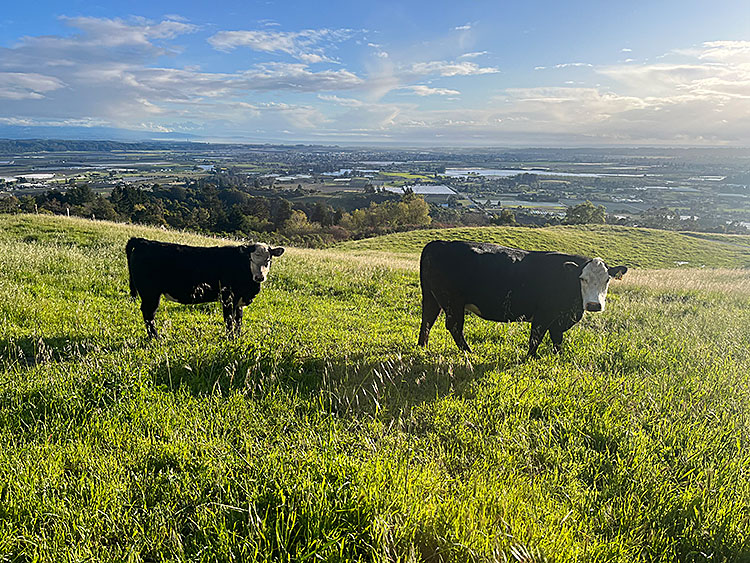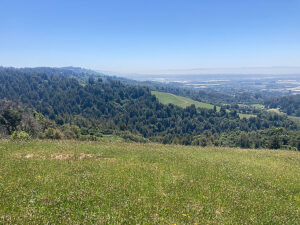On March 25, the Land Trust of Santa Cruz County announced that the Estrada Ranch — 1,205 mountainous acres in the heart of the Pajaro Hills in Santa Cruz County — has been protected in perpetuity through a conservation easement.
This arrangement between the Land Trust and the Frank Estrada family will keep the land in productive use while permanently protecting it from development.
“I feel strongly that preserving our ranch is what the prior generations would have wanted us to do,” said Greg Estrada. “We take pride in being good stewards of the land and by us partnering with Land Trust of Santa Cruz County and Peninsula Open Space Trust, the Estrada ranch will now forever be preserved.”
Dominated by coast redwood forest, oak woodland, and grassland, the property provides an example of how working lands and wildlife habitat can exist side-by-side — and even thrive when managed sustainably. Keystone mammal species are known to use or travel through the property, including mountain lion, bobcat, and American badger.
 The Land Trust said this sprawling ranch will significantly improve the continuity of protected lands in the eight-mile span along the highest ridgeline running between the Soquel Demonstration State Forest and Forest of Nisene Marks State Park to Mount Madonna County Park, creating a 5,800-acre contiguous protected area.
The Land Trust said this sprawling ranch will significantly improve the continuity of protected lands in the eight-mile span along the highest ridgeline running between the Soquel Demonstration State Forest and Forest of Nisene Marks State Park to Mount Madonna County Park, creating a 5,800-acre contiguous protected area.
“This Ranch has been in the family for five generations and it is home, but due to the passing of the most recent generation and the land ownership structure we were always prepared to lose more than half of the ranch in future transactions,” explains Grant Estrada. “With help from POST and the Land Trust of Santa Cruz, we have been able to preserve the ranch for future generations. The outcome couldn’t have been better.”
Threatened Species
The ranch’s remarkable mix of habitats—ranging from redwood forest to chapparal—supports a rich array of species. Important resources on the property include multiple native-dominant habitat types, headwaters of regionally important creeks (Green Valley Creek, Browns Creek, and Casserly Creek), and intact wildlife corridors.
Focal species include blacktailed deer (Odocoileus hemionus columbianus), mountain lion (Puma concolor), and coastal steelhead (Oncorhynchus mykiss irideus).
Overall, the property is in exceptional ecological health, according to the Land Trust.
Riparian and wetland areas on the property support habitat for the California red-legged frog, a federally threatened and state species of special concern.
Multiple other unconfirmed species have suitable habitat on parts of Estrada Ranch. These include the Santa Cruz black salamander, California tiger salamander, and potentially Cooper’s Hawk and bald eagle.
New Approach
Through thoughtful management, the Frank Estrada family has ensured the ecological health of the property has remained intact for decades. This multi-stage land protection project began with the $10.6 million purchase of 839 acres of the ranch in 2023 by Peninsula Open Space Trust.
The new easement purchase by the Land Trust of Santa Cruz County ensures that ownership of the whole property returns to the family while the flora, fauna, habitats, and ecology of the ranch and working forest remain free from threats of development and disturbance.
“This land protection strategy is unique in that it allows us to achieve dual conservation outcomes,” said Sarah Newkirk, the Land Trust’s executive director, “preserving habitat and a critical piece of the wildlife corridor between the Santa Cruz Mountains and the Gabilan Range while enabling the Estrada family to continue their generational working ranch.”
The Land Trust partnered with Peninsula Open Space Trust, Cal Fire, the California Strategic Growth Council, and the California Department of Conservation to secure the easement valued at over $12 million.
One third of the purchase price was raised through private donations, including a $2 million contribution from the Land Trust of Santa Cruz County.
“This conservation easement safeguards sensitive ecosystems, while allowing generational landowners to continue ranching and sustainable timber harvesting activities,” said Jennifer Lucchesi, Department of Conservation director. “Protecting this land from development is also critical for environmental health, which provides our native species with food, water, shelter, and space.”
Cal Fire’s Forest Legacy Program funds landscape-scale conservation projects to conserve working forests and working forested landscapes.
Peter Leuzinger, Cal Fire’s Deputy Chief of Forestry Assistance, said, “Cal Fire’s $4.5 million dollar investment in the Estrada Ranch Conservation Easement project helped prevent forest fragmentation and conversion to nonforest uses, and that is incredibly important not only to the community, but for the local ecosystem as well.”
Gordon Clark, president of POST, said, “POST is honored to have participated in this complex transaction and the permanent protection of this environmentally rich and historically significant property. With the Estrada family’s commitment to conservation plus the generous support of our donors and other financial backers, we are proud to have been able to help finance this project and contribute over $2.5 million into this vital landscape linkage.”
This effort is part of the Land Trust’s strategic priority to protect habitat for biodiversity and steward high-value at-risk lands.
The easement will contribute 1,205 acres to the organization’s goal of protecting 6,000 acres of habitat in the Santa Cruz to Gabilan landscape linkage by 2028.
Funds for the easement were made available through the California Strategic Growth Council’s Sustainable Agricultural Lands Conservation Program in collaboration with the Department of Conservation.
The Growth Council’s Affordable Housing and Sustainable Communities Program complements investments made in urban areas with the purchase of agricultural conservation easements, development of agricultural land strategy plans, and mechanisms that result in greenhouse gas reductions and a more resilient agricultural sector.
The program invests in agricultural land conservation with revenue from California Climate Investments derived from quarterly cap-and-trade auction proceeds administered by the California Air Resources Board. The Department of Conservation works in cooperation with the Natural Resources Agency as the implementation partner.



